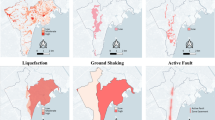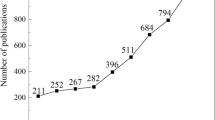Abstract
Previous pedestrian evacuation modeling for tsunamis has not considered variable wave arrival times or critical junctures (e.g., bridges), and did not effectively communicate multiple evacuee travel speeds. We summarize an approach that identifies evacuation corridors, recognizes variable wave arrival times, and produces a map of minimum pedestrian travel speeds to reach safety, termed a “beat-the-wave” (BTW) evacuation analysis. We demonstrate the improved approach by evaluating difficulty of pedestrian evacuation of Seaside, Oregon, for a local tsunami generated by a Cascadia subduction zone earthquake. We establish evacuation paths by calculating the least-cost distance (LCD) to safety for every grid cell in a tsunami hazard zone using geospatial, anisotropic path distance algorithms. Minimum BTW speed to safety on LCD paths is calculated for every grid cell by dividing surface distance from that cell to safety by the tsunami arrival time at safety. We evaluated three scenarios of evacuation difficulty: (1) all bridges are intact with a 5-min evacuation delay from the start of earthquake, (2) only retrofitted bridges are considered intact with a 5-min delay, and (3) only retrofitted bridges are considered intact with a 10-min delay. BTW maps also take into account critical evacuation points along complex shorelines (e.g., peninsulas, bridges over shore-parallel estuaries) where evacuees could be caught by tsunami waves. The BTW map is able to communicate multiple pedestrian travel speeds, which are typically visualized by multiple maps with current LCD-based mapping practices. Results demonstrate that evacuation of Seaside is problematic seaward of the shore-parallel waterways for those with any limitations on mobility. Tsunami vertical evacuation refuges or additional pedestrian bridges may be effective ways of reducing loss of life seaward of these waterways.











Similar content being viewed by others
Change history
11 January 2018
Due to a procedural error in construction of Figs. 8 and 9, listed minimum speeds to beat the tsunami wave in areas of Seaside seaward of Neawanna Creek are too high. The two figures should be replaced by the new figures below.
Abbreviations
- BTW:
-
Beat-the-wave
- CSZ:
-
Cascadia subduction zone
- DOGAMI:
-
Oregon Department of Geology and Mineral Industries
- NOAA:
-
National Oceanic and Atmospheric Administration
References
California Geological Survey (2015) CGS tsunami web site: California Geological Survey. http://www.conservation.ca.gov/cgs/geologic_hazards/Tsunami/Inundation_Maps/Pages/Index.aspx. Accessed 4 Apr 2015
Connor D (2005) The City of Seaside’s Tsunami Awareness Program: outreach assessment—how to implement an effective tsunami preparedness outreach program, Oregon Department of Geology and Mineral Industries Open-File Report O-05-10
Fraser SA, Wood NJ, Johnston DM, Leonard GS, Greening PD, Rossetto T (2014) Variable population exposure and distributed travel speeds in least-cost tsunami evacuation modelling. Nat Hazards Earth Syst Sci 14(11):2975–2991
Gonzalez FI, Geist EL, Jaffe B, Kanoglu U, Mofjeld H, Synolakis CE, Titov EE, Arcas D, Bellomo D, Carlton D, Horning T, Johnson J, Newman J, Parson T, Peters R, Peterson C, Priest G, Venturato A, Weber J, Wong F, Yalciner A (2009) Probabilistic tsunami hazard assessment at Seaside, Oregon, for near-and far-field seismic sources. J Geophys Res 114:1–19
Imhof E (1950) Gelände und Karte. Eugen Rentsch Verlag, Erlenbach
Johnstone W, Lence B (2012) Use of flood, loss, and evacuation models to assess exposure and improve a community tsunami response plan—Vancouver Island. Nat Hazards Rev 13(2):162–171
Jonkmann S, Vrijling J, Vrouwenvelder A (2008) Methods for the estimation of loss of life due to floods: a literature review and a proposal for a new method. Nat Hazards 46:353–389
Laghi M, Cavalletti A, Polo P (2006) Evacuation routes tools ArcGIS toolbox user’s manual. Italian Ministry for the Environment and the Territory and Asian Disaster Preparedness Center. http://www.adpc.net/v2007/Downloads/2007/May/EVACUATION%20ROUTES%20TOOLS%20A5_for_print.pdf. Accessed 16 July 2010
Langlois JA, Keyl PM, Guralnik JM, Foley DJ, Marottoli RA, Wallace RB (1997) Characteristics of older pedestrians who have difficulty crossing the street. Am J Public Health 87(3):393–397
Madin IP, Wang Z (1999) Relative earthquake hazard maps for selected urban areas in western Oregon. Oregon Department of Geology and Mineral Industries IMS-10
Margaria R (1938) Sulla fisiologia e specialmente sul consume energetico della marcia e della corsa a varie velocita ed inclinazioni del terreno. Atti Accad Naz Lincei Memorie, pp 299–368. Cited in Biomechanics and Energetics of Muscular Exercise (1976). Clarendon Press, Oxford, pp 69–75
Margaria R (1976) Biomechanics and energetics of muscular exercise. Clarendon Press, Oxford
Mas E, Adriano B, Koshimura S (2013) An integrated simulation of tsunami hazard and human evacuation in La Punta, Peru. J Disaster Res 8:285–295
National Agriculture Imagery Program (2009) 1 meter Clatsop County MrSID Mosaic. USDA/FSA—Aerial Photography Field Office, Salt Lake City, UT
National Geophysical Data Center/World Data Service for Geophysics (2015) Global historical tsunami database. www.ngdc.noaa.gov/hazard/tsu_db.shtml. Accessed 1 Apr 2015
Oregon Department of Geology and Mineral Industries (2013) Tsunami evacuation map Seaside & Gearhart, Oregon. Oregon Department of Geology and Mineral Industries. http://www.oregongeology.org/pubs/tsubrochures/SeasideGearhartEvacBrochure-6-3-13_onscreen.pdf. Accessed 10 Oct 2014
Paul S (2013) What are the right walking and running speeds? Runner’s World. http://www.runnersworld.com/beginners/what-are-right-walking-and-running-speeds. Accessed 17 Apr 2015
Peterson GN (2014) GIS cartography: a guide to effective map design, 2nd edn. CRC Press, Boca Raton, p 106
Priest GR, Goldfinger C, Wang K, Witter RC, Zhang Y, Baptista AM (2009) Tsunami hazard assessment of the Northern Oregon coast: a multi-deterministic approach tested at Cannon Beach, Clatsop County, Oregon. Oregon Department of Geology and Mineral Industries Special Paper 41
Priest GR, Witter, RC, Zhang Y, Wang K, Goldfinger C, Stimely LL, English JT, Pickner SG, Hughes KLB, Wille TE, Smith RL (2013a) Tsunami animations, time histories, and digital point data for flow depth, elevation, and velocity for the Clatsop Project Area, Clatsop County, Oregon. Oregon Department of Geology and Mineral Open-File Report O-13-18
Priest GR, Witter RC, Zhang Y, Wang K, Goldfinger C, Stimely LL, English JT, Pickner SG, Hughes KLB, Wille TE, Smith RL (2013b) Tsunami inundation scenarios for Oregon. Oregon Department of Geology and Mineral Industries Open-File Report O-13-19
Priest GR, Watzig RJ, Madin IP, Stimely L (2015) Local tsunami evacuation analysis of Seaside and Gearhart, Clatsop County, Oregon. Oregon Department of Geology and Mineral Industries Open-File Report O-15-02
Soule RG, Goldman RF (1972) Terrain coefficients for energy cost prediction. J Appl Physiol 32(5):706–708
Tobler W (1993) Three presentations on geographical analysis and modeling; 1) non-isotropic geographic modeling, 2) Speculations on the geometry of geography, 3) global spatial analysis. University of California Santa Barbara, National Center for Geographic Information and Analysis Technical Report 93-1
US Census Bureau (2015) American FactFinder. http://factfinder2.census.gov/faces/nav/jsf/pages/index.xhtml. Accessed 1 Apr 2015
U.S. Geological Survey (USGS) (2012) The March 11 Tohoku earthquake, one year later. What have we learned? USGS, science features blog post, March 9, 2012. http://www.usgs.gov/blogs/features/usgs_top_story/the-march-11-tohoku-earthquake-one-year-later-what-have-we-learned/. Accessed 9 Sept 2014
Watershed Sciences (2009) LIDAR remote sensing data collection. http://www.oregongeology.org/sub/projects/olc/watershedsci/North_Coast_Lidar_Report_2009.pdf. Accessed 1 Aug 2014
Wilson RI, Miller KM (2014) FASTER tsunami height calculation: background information and guidance for use. California Geological Survey Special Report 236
Wilson RI, Barberopoulou A, Miller KM, Goltz JD, Synolakis CE (2008) New maximum tsunami inundation maps for use by local emergency planners in the State of California, USA. EOS Trans Am Geophys Union 89(53) Fall Meeting Supplement, Abstract OS43D-1343
Witter RC, Zhang YJ, Wang K, Priest GR, Goldfinger C, Stimely L, English JT, Ferro PA (2011) Simulating tsunami inundation at Bandon, Coos County, Oregon, using hypothetical Cascadia and Alaska earthquake scenarios. Oregon Department of Geology and Mineral Industries Special Paper 43
Wood N (2007) Variations in community exposure and sensitivity to tsunami hazards in Oregon. US Geological Survey Scientific Investigations Report 2007-5283, Reston
Wood N, Schmidtlein M (2012) Anisotropic path modeling to assess pedestrian-evacuation potential from Cascadia-related tsunamis in the U.S. Pacific Northwest. Nat Hazards 62(2):275–300
Wood N, Schmidtlein M (2013) Community variations in population exposure to near-field tsunami hazards as a function of pedestrian travel time to safety. Nat Hazards 65(3):1603–1628
Wood N, Jones J, Spielman S, Schmidtlein M (2015) Community clusters of tsunami vulnerability in the US Pacific Northwest. Proc Natl Acad Sci. doi:10.1073/pnas.1420309112
Yeh H, Fiez T, Karon J (2009) A comprehensive tsunami simulator for Long Beach Peninsula. Phase 1: framework development. Wash State Military Department 27, Tacoma
Acknowledgements
This project was funded under award #NA13NWS4670013 by the National Oceanic and Atmospheric Administration (NOAA) through the National Tsunami Hazard Mitigation Program and by the US Geological Survey Land Change Science Program. We thank Mara Tongue and Jeanne Jones of the USGS, Mathew Schmidtlein of California State University Sacramento and two anonymous reviewers for their insightful reviews of the manuscript. Any use of trade, product, or firm names is for descriptive purposes only and does not imply endorsement by the US government.
Author information
Authors and Affiliations
Corresponding author
Additional information
A correction to this article is available online at https://doi.org/10.1007/s11069-017-3154-2.
Rights and permissions
About this article
Cite this article
Priest, G.R., Stimely, L.L., Wood, N.J. et al. Beat-the-wave evacuation mapping for tsunami hazards in Seaside, Oregon, USA. Nat Hazards 80, 1031–1056 (2016). https://doi.org/10.1007/s11069-015-2011-4
Received:
Accepted:
Published:
Issue Date:
DOI: https://doi.org/10.1007/s11069-015-2011-4




